I Dream of the West
“It seems to me that the strangeness and wonder of existence are emphasized here, in the desert, by the comparative sparsity of flora and fauna: life not crowded upon life as in other places, but scattered abroad in spareness and simplicity, with a generous gift of space for each herb and bush and tree, each stem of grass, so that the living organism stands out bold and brave and vivid against the lifeless sand and barren rock. Love flowers best in openness and freedom.” –Edward Abbey, “Desert Solitaire”
From the shelter of my small apartment, I gaze out at a frozen scene. Rows of houses are covered in heavy snow, with chimneys struggling to exhale in -40°F temperatures. From within the static, tame environment of the indoors, the world can feel very small. Here, restless in the frigid town of Dawson Creek, Canada, my mind begins to soar.
I am transported back to the labyrinths of burning red rock in Utah’s Canyonlands National Park, where I traveled by bike a few years ago. I remember the vast stretches of sagebrush in Idaho, the forested mountains and meandering river valleys of Montana, and the otherworldly saguaro forests of Arizona. Long before the pandemic hit and forced us into a more insular way of life, my mind had wandered to these places as a teenager.
I fell hard for the allure of the American West. Perhaps blame it on pop culture, but for me, this part of the world became synonymous with nomadism and a great sense of freedom in its vastness. I fantasized about meeting fellow travelers — the road weary and eccentric. We would share stories over a campfire as it illuminated an impressive backdrop of red rocks guarded by the shadows of giant saguaro cacti. It all sounds idealized and naive, but often that is the backbone of dreams. Once I discovered cycle touring as a way to explore, my desire to ride through the West became even stronger. About 20 countries and tens of thousands of miles later, I finally made it to this part of the world in the summer of 2019.
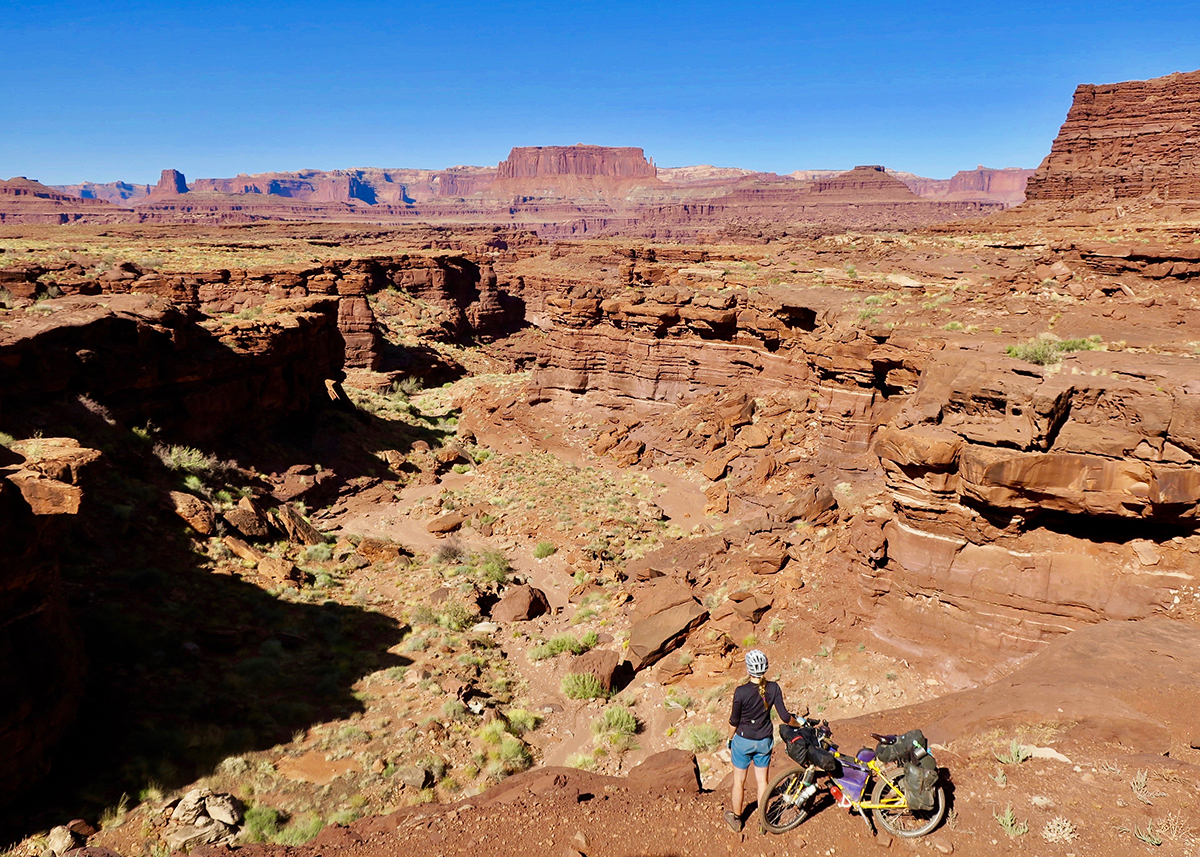
Now, as I sit here at home in Dawson Creek during a pandemic, I am reminded of the power of dreams. The vastness and beauty of the West took a hold on me and haven’t let go. I push through the tougher times in its memory.
As many bicycle travelers can probably attest, change happens slowly. That is one thing that I have always loved about this mode of travel. A cyclist experiences subtle transitions in the landscape. We feel the rise and fall of contours in our burning legs. Following the Western Wildlands Route, I traveled through familiar landscapes of forested mountains and river valleys in Montana and Idaho. Over months, the land slowly morphed into the spectacular and completely alien red rock canyons of Utah and wild desert flora of Arizona. Among these locations, some of my favourite places to ride were the plains in between, namely the vast Snake River Plain of Idaho.
The crossing of this intermountain plain brought back memories of pedaling through the Australian Outback or Mongolia. The skies dominated, tucked into a sea of sagebrush from where the odd lone peak swelled in the distance. I rode along a washboard dirt road into a strong headwind emerging from a storm building in the distance. I had only seen two vehicles in the past few hours. Dark clouds swirled in vicious forms across the horizon as they began to merge into a singular gray entity. To avoid disaster, I decided to stop and pitch my tent early. I ended up doing so just in time. Twenty minutes later, the storm arrived. The wind and rain were so strong that I had to hold onto the poles in fear that they would collapse. Thankfully, the storm passed quickly, and soon all became still. I opened my vestibule and watched as the clouds pulled the storm away across the treeless plain. The sun’s rays pushed through the dark skies and painted the scrublands in gold. It was a surreal sight. The next morning, I continued southward in good weather and light wind across the great wide open. There is something very powerful about riding alone in such a big landscape.
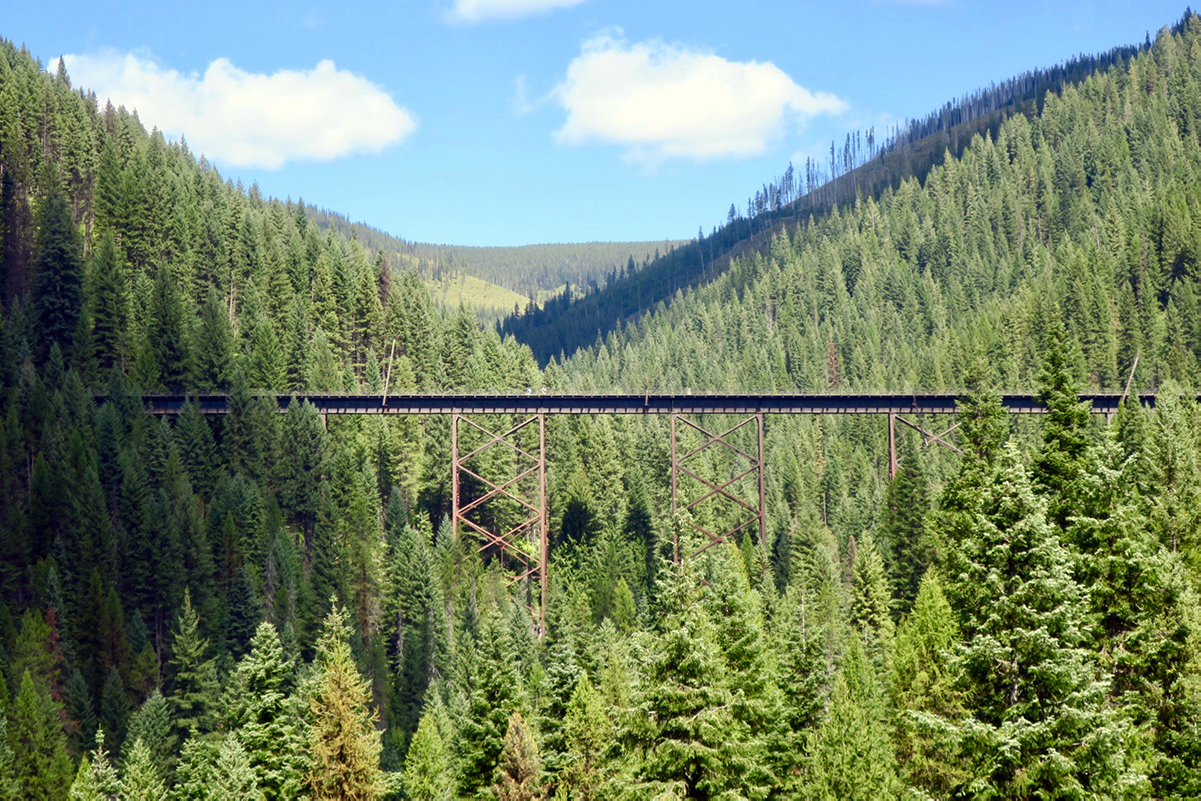
Without human voices, the land does the talking. It communicates in shifting shadows across open plains and whispers in trickling streams. I was definitely alone, but the feeling of loneliness wasn’t present. I felt almost adrift from myself. My mind was in the land and nothing else. But in between these moments of solitude, I always looked forward to spontaneous encounters with other humans. This is something I long for and greatly miss in the confines of the pandemic. On a bicycle tour, I have often said that the people make the trip, and this was also true of my ride in the American West. The wilderness is thrilling, but for me, it is the human connection that brings about that feeling of home while on the road.
After leaving the Snake River Plain, I ended up in a small town called Soda Springs, Idaho, where I spent a few nights waiting out some foul weather. I stayed in one of the basement rooms of a cheap hotel. There I met a long-haul trucker and his apprentice. His rig had broken down, and they were staying at the hotel to kill time until things were repaired. He had a crockpot of beef stew cooking in their room and offered me as much as I wanted. With my cycling appetite, I probably could have eaten the entire thing. It was one of the most delicious stews I have ever had. In their tiny box of a room, much like mine, we shared stories from the road. He had a deep, gravelly voice, one that you would hear on a Dodge truck commercial. It was full and captivating — a sort of anthem for the open road. He talked about all the corners of the country he had seen and the characters he had met. I got the sense that he genuinely loved his job.
His dream was to drive to Alaska.
It made for an interesting break on a rainy day — a glimpse into a nomadic life very different than mine. About a week prior, I had met another memorable character.
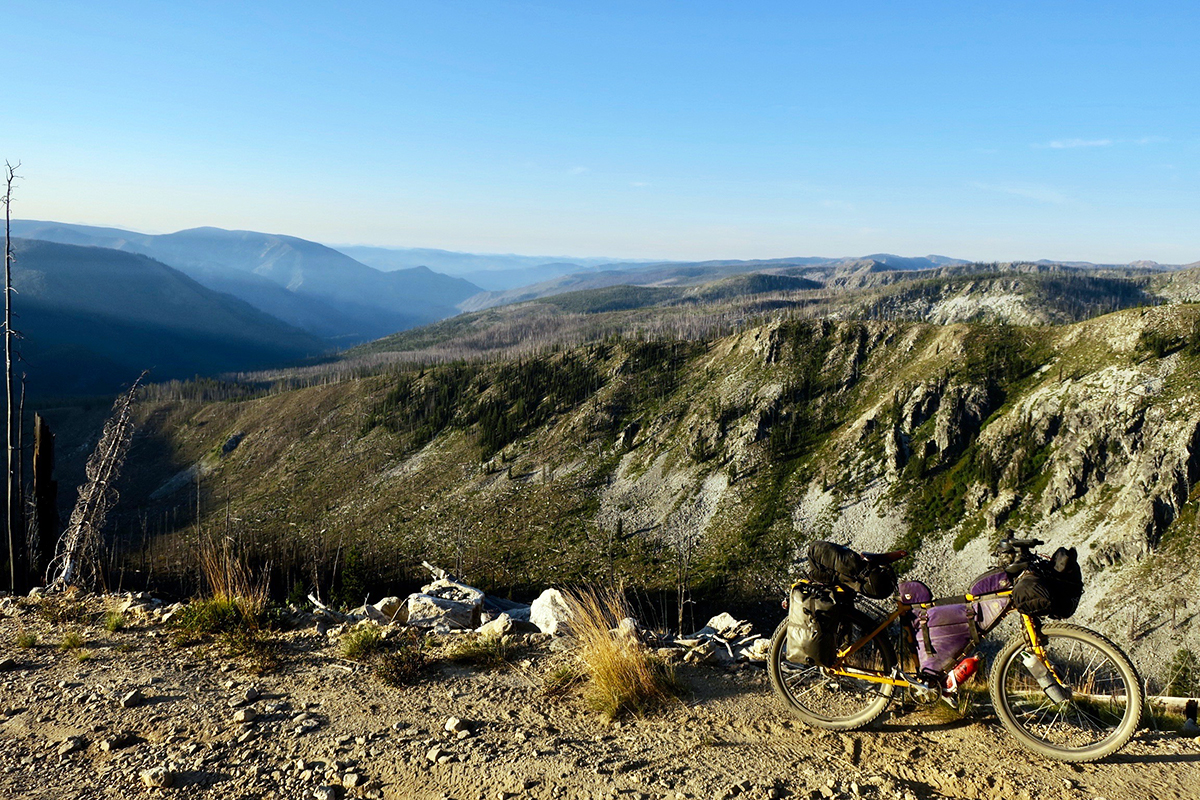
I was racing downhill into the tiny outpost of Elk City, Idaho, (population 147 — definitely no city) when I saw a man waving with one hand and a can of beer in the other by the side of the road.
“Hi! Want a cold beer?!” he yelled out.
“Uhh … yes, please!” I beamed.
John was decked out head to toe in camouflage and had a thick moustache that seemed to take over his whole face like a cartoon when he smiled. He was one of the friendliest people I have ever met. He was also an enthusiastic road cyclist, which one would not immediately assume by his appearance. A beer and a conversation turned into an invitation to stay for the night. He lived with his wife in Lewiston, Idaho, and would occasionally come back to their home in Elk City to hunt. He was really into hunting — pretty much lived and breathed it. Inside his humble abode, he had many mounted heads of large ungulates and impressive rugs. He had a thick Idahoan accent, as dense as his moustache. He pronounced creek like “crick” and “him” like “eem.” He treated me to his favourite dinner of chili dogs (hot dogs smothered in canned chili, cheese, and onion), and told me to help myself to a giant box of Snickers bars.
“My wife usually cooks all sorts of stuff, real healthy, but this is my go-to!” he said.
I asked him where he thought the name “Elk City” came from.
“Well,” he said, “I think someone just looked out at the field one day and saw a whole bunch of elk!”
I probably should have guessed that one. It was a great night with John the elk hunter from Elk City.
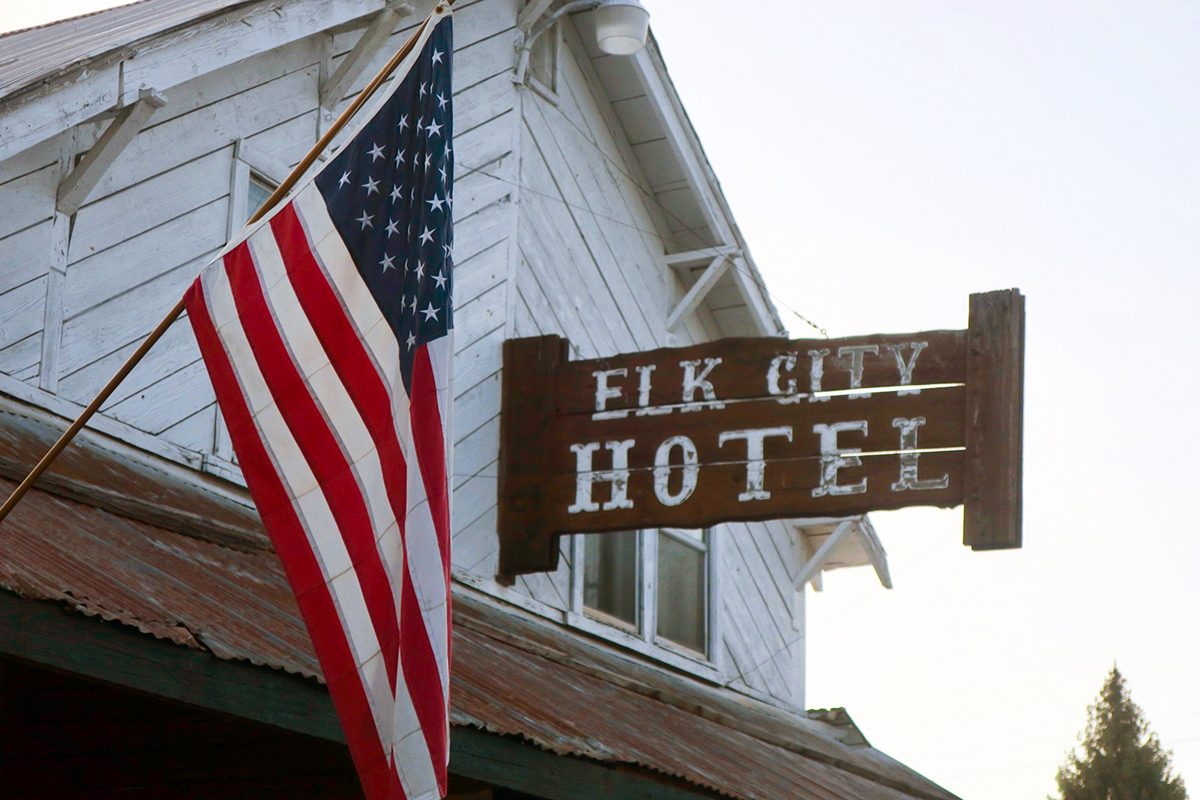
Idaho really stood out for the warmth of its people who greeted me in between its corridors of wilderness. But I encountered such kindness in every state throughout my ride. I felt like I never passed through a single town without someone giving me praise for what I was doing or
offering their assistance. I didn’t meet many fellow bicycle travelers until the Sawtooth Valley in Idaho.
I had only seen a few bikepackers over the past month and a half, and then I suddenly saw groups of two, five, and 10 on the same day. It turned out the Idaho Smoke ‘n’ Fire 400 bikepacking race was passing through. Several people stopped to ask me why I was going the wrong way. Others just stopped to have a chat. One was dressed in a hula skirt and lei, smiling away. By his goofy grin and slightly delayed answers to my questions, I figured he was very sleep deprived. He confirmed my assumption when he said that he had only slept a few hours — I can’t remember if he meant the previous night or running total. The life of a bikepacking racer!
It was great to be among a large community of cyclists — my people. Nights were getting chilly in the valley, and by late September in southern Idaho, the winter was slowly beginning to close in. I spent several mornings waiting for the heavy frost to thaw from both bike and tent. I was moving closer and closer to my most anticipated state, Utah.
Just outside of Moab, I wild camped in a large open area where a few RV travelers had also set up. I passed a particularly large encampment with several trailers, tables, chairs, eBikes, motorbikes, and a large Grateful Dead flag flapping proudly in the wind. This was the “FOG” encampment — the “F***ing Old Guys,” as my new friends called themselves. Coming together from various parts of the country, these 50- or 60-somethings made a yearly pilgrimage to the Moab area to hang out, eat, drink, and rip around on bikes. One was permanently nomadic, living out of his trailer while his wife held a seasonal job as a park ranger in Moab. A hot topic of conversation was a new law put in place to allow ATVs in a particular section of Canyonlands National Park, where they had been previously prohibited. No one in the group was at all impressed due to the noise and environmental degradation that they caused. This crew was hilarious, easygoing, and fairly wacky. The husband and wife were both particularly amusing. They both used the word f**k so much in their speech, it replaced commas.
I was spoiled with food and drink into the late hours of the night by firelight in the desert. With Jason Isbell playing in the background, we exchanged nomadic tales. We talked about music and life on the road. The sound of human voices illuminated the rich darkness, creating a temporary home in the desert night. I was eager to start the next phase of the journey, following a section of the Plateau Passage Bikepacking Route into Canyonlands National Park.
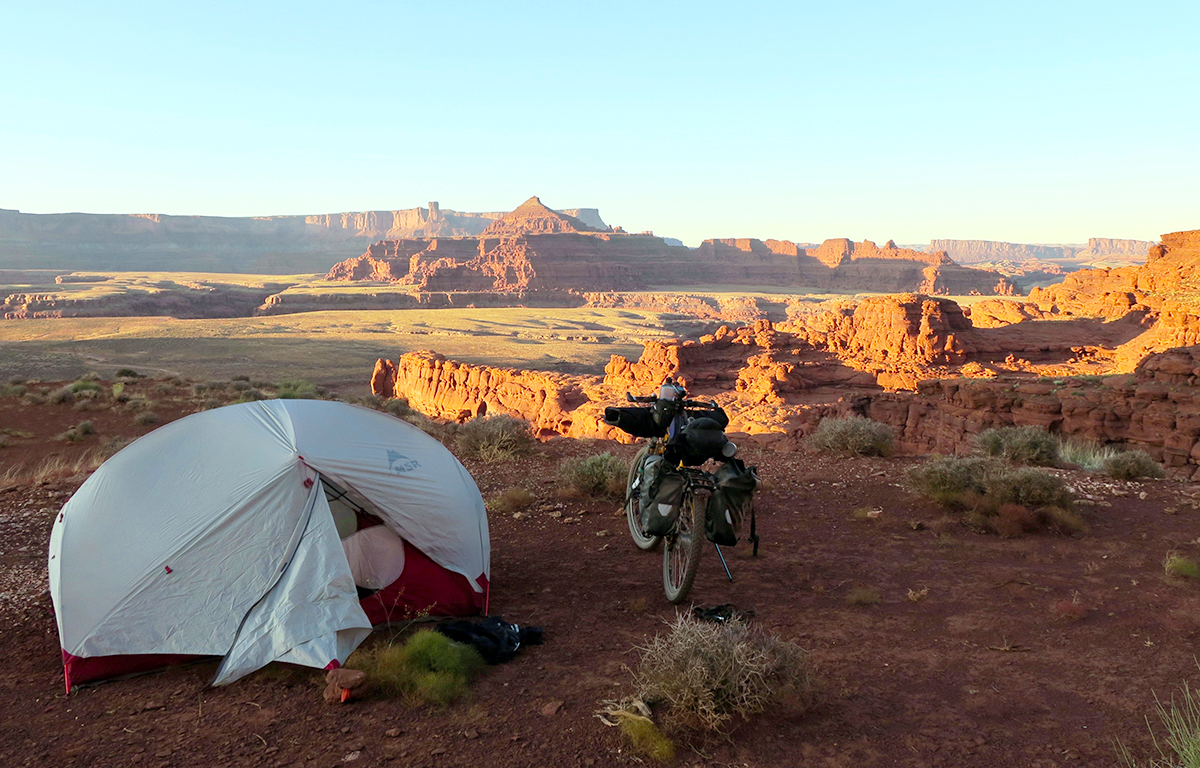
I have pedaled through spectacular mountain ranges and past meadows of wildflowers and piercing blue lakes, but nothing has entranced me as much as the deserts of southern Utah. Riding east toward Moab, the land slowly reached skyward from the sagebrush plains into great fortresses of red rock. This is what I had come for. The riding became rougher and sandier, and dragging my bike through old creek beds and washes became part of the routine.
The first 10 miles out of Moab were anything but serene. The dirt road into Canyonlands National Park was heavily trafficked with ATVs ripping past me in what felt like one-minute intervals. This brought to mind the anti-ATV conversation with the FOG crew from the previous night. The scenery, however, was absolutely spectacular — these were the rich red mesas and tablelands of my dreams. Eventually, I got to the turnoff for Lockhart Basin “road,” which closely resembled a creek bed. As the quality of the road rapidly declined, the steady stream of 4×4 traffic almost instantly disappeared.
The rest of the route through Canyonlands was slow going. The dirt tracks were rock strewn and sandy, and I was pushing more often than I was riding. None of this seemed to matter because of how awe inspiring the landscape was. After a tremendous amount of effort, I reached a high point. A massive kingdom of buttes and canyons stretched out in all directions. The early evening light set the landscape on fire. The hue was so brilliant that it seemed to burn from within the rock itself, glowing like an ember. I pitched my tent in one of the most beautiful spots I’d ever seen. It was just me and this red planet with no humans or vehicles to be seen in any direction. This single vista is what I had fantasized about as a teenager and where my mind wanders back to in isolation, awake and dreaming.
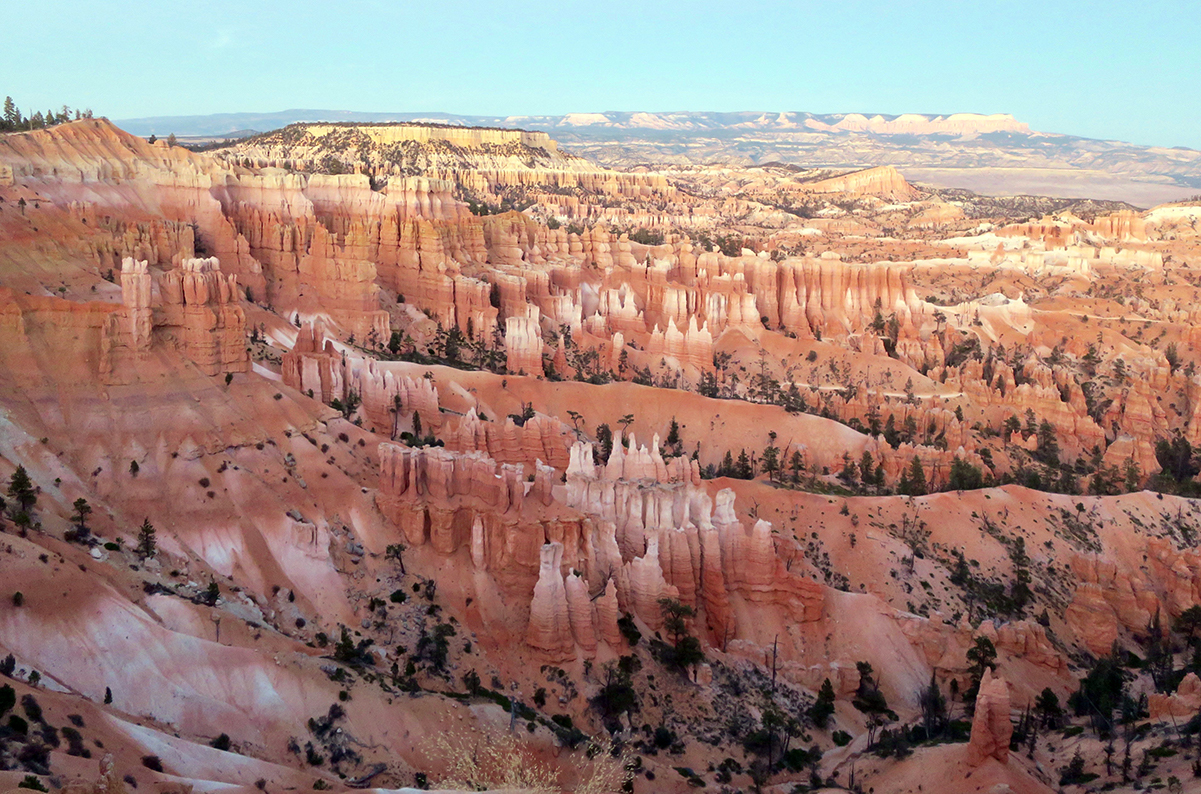
My ride across Utah captivated me from start to finish. It was challenging, remote, spectacular. Staring out at Bryce Canyon was a definite highlight. Seeing the pink hoodoos at sunset is another scene I will never forget. Soon I left Utah behind and entered my final state, Arizona. A new and wonderful type of desert began to emerge. The Western Wildlands Route that I had been following from the Canadian border crossed a segment of the Navajo Nation, another highlight of the ride.
My journey through the Navajo lands was lonely and meditative. I came across only two other vehicles and groups of wild horses on the two-day crossing. One was a large family crammed into a pickup hauling a water tank to their home. The other was a friendly man joking that I was scaring the wild horses — he said that while they didn’t seem to be fazed by vehicles, they were spooked by bicycles and motorbikes. The landscape was wide open and barren, with the odd monolith or hogan (traditional Navajo dwelling) dotting the horizon. I pedaled across vast grasslands on perfect stretches of doubletrack. It was bliss. At the end of the first day, I camped high up on a windy plateau with a gigantic view of the area. Like in Canyonlands, there was no one to be seen — only one hogan many miles away.
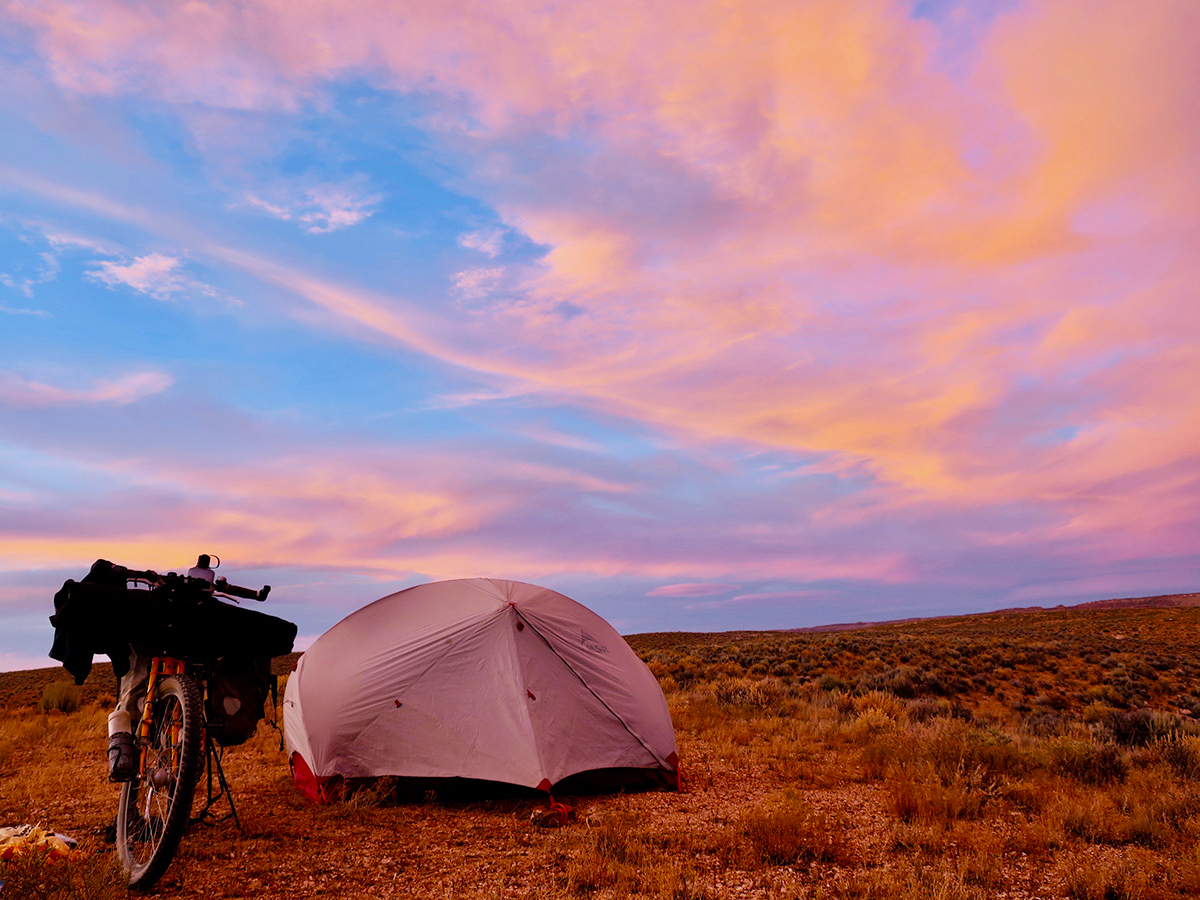
After I finished setting up my tent, the wind died down. The setting sun exploded across the sky in oranges, pinks, and purples against piercing blue. High on that ledge, the spectacle surrounded me in all directions. If I were a religious person, I might say that a kind of god revealed itself at that moment. I felt so incredibly small, and all I could see and feel was sky. Eventually, the bright blue deepened to navy, then to black, and the brilliant colours faded into darkness.
Arizona was more diverse than I could have imagined. While I was familiar with the famous scenes of the Grand Canyon, the pink cliffs of Sedona, and saguaro cacti, I wasn’t aware of how much of the state was dominated by pine forests and even mountains! The attitude of the locals was also a bit different than what I had experienced in the other states. There seemed to be a bit of paranoia in these parts.
“Can’t trust anyone in this area.”
“Watch out for illegals.”
“I hope you have a motor on that thing to get away from all the weirdos!”
One man even gave me $20 to buy pepper spray! This of course didn’t represent all of my encounters in the state as there was always the element of kindness that I had already experienced across the rest of the country.
My one unnerving encounter wasn’t of the human kind. Camped beside a dirt road high above the town of Globe, I heard a terrifying and hoarse growl beside my tent. It almost sounded like a human imitating a wildcat. I’m guessing that it was a wildcat, of course. I yelled out “Hey-ooo!” and threw a rock outside. It took me an hour and a very full bladder to get the courage to leave the tent. I took a quick glimpse in all directions for the mysterious creature. Nothing. The lights of Globe were glowing faintly in the distance, too far away for comfort. I had one of the worst sleeps of the trip. The ride from Young to Globe, however, was a definite highlight of Arizona.
I followed a dirt road out of the tiny community of Young through forested hills and onto a pine-covered plateau. Then a glorious descent to the Salt River took me into a desert wonderland of saguaro cacti and other fantastic, alien-like desert flora. The giant cacti were everywhere, standing tall like a proud army guarding the hillsides. I was giddy with excitement — this was yet another desert fantasy coming to life. Out in the open on a bicycle, I could slowly drink it all in. A week later, I reached my end goal: 3,300 miles and almost three months later, I arrived at the Mexican border.
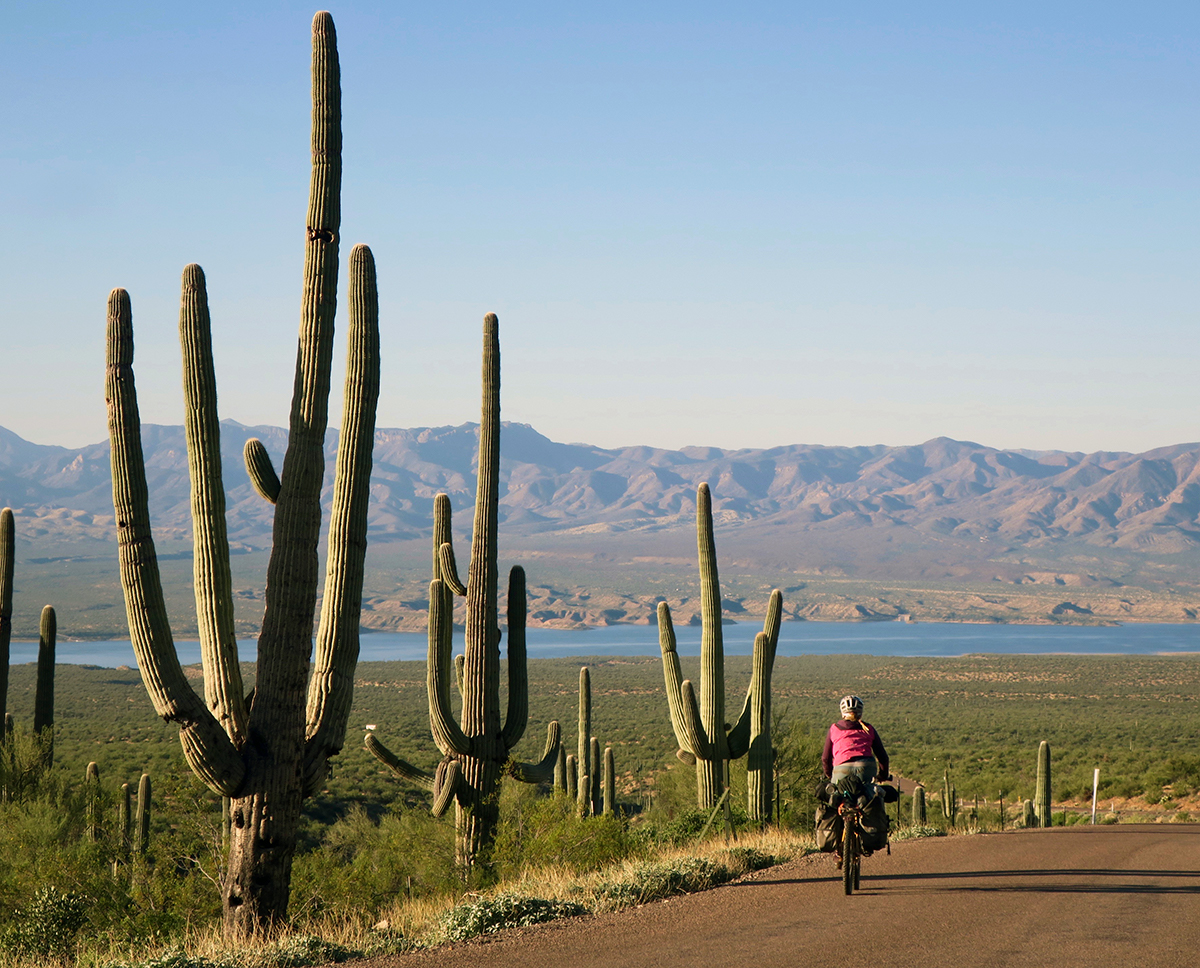
The journey’s end was fairly anticlimactic, just the border fence and about half a mile of pushing through a prickly overgrown trail to get to it. At the end of my ride, my body bore the characteristics of the land — sun scorched and weary from the elements. My skin was dry and burnt with cracked lips and aching legs. I was tired, worn down, but deeply satisfied. I recalled something that a hiker told me on a remote road above Flagstaff, Arizona.
“You look feral,” he said, “but in the best way.”
The West had given me all that I had wanted. The sun-baked landscape left an imprint on me.
Now, two years later, back at home in Dawson Creek, Canada, during a pandemic, the spirit of the American West still lives within me. As I gaze outside at the snowy scene, I long for those sunny, strenuous days following Montana and Idaho’s rivers and wide plains, Utah’s canyonlands or Arizona’s saguaro forests. If I could just breathe some creativity into my thoughts, the wintery scene outside could almost be seen as a desert in itself. It is a silent, frozen one. In its own way, it is peaceful. Like the desert southwest, any small expression of life stands out. Here, it could be a tiny bud flashing its green hue at the first sign of spring. It is a beautiful display of resilience in a harsh landscape. Out on the bike, one notices these subtleties — that lone bright wildflower on a desert dirt road or the slow sunburnt smile from a small-town local.
Soon the harsh winter will fade away and colour will return to the land. The time will arrive to explore again by bike, but this summer I will be keeping it closer to home in British Columbia. My tour of the American West exposed me to landscapes unlike anything I’d ever seen, even
after years of cycling around the world. The beauty in the new and unfamiliar keeps the fire burning in me to explore further.
But these far and distant lands will have to wait for now. There is much beauty to be seen from the saddle just beyond our front door. We just have to look closer.

